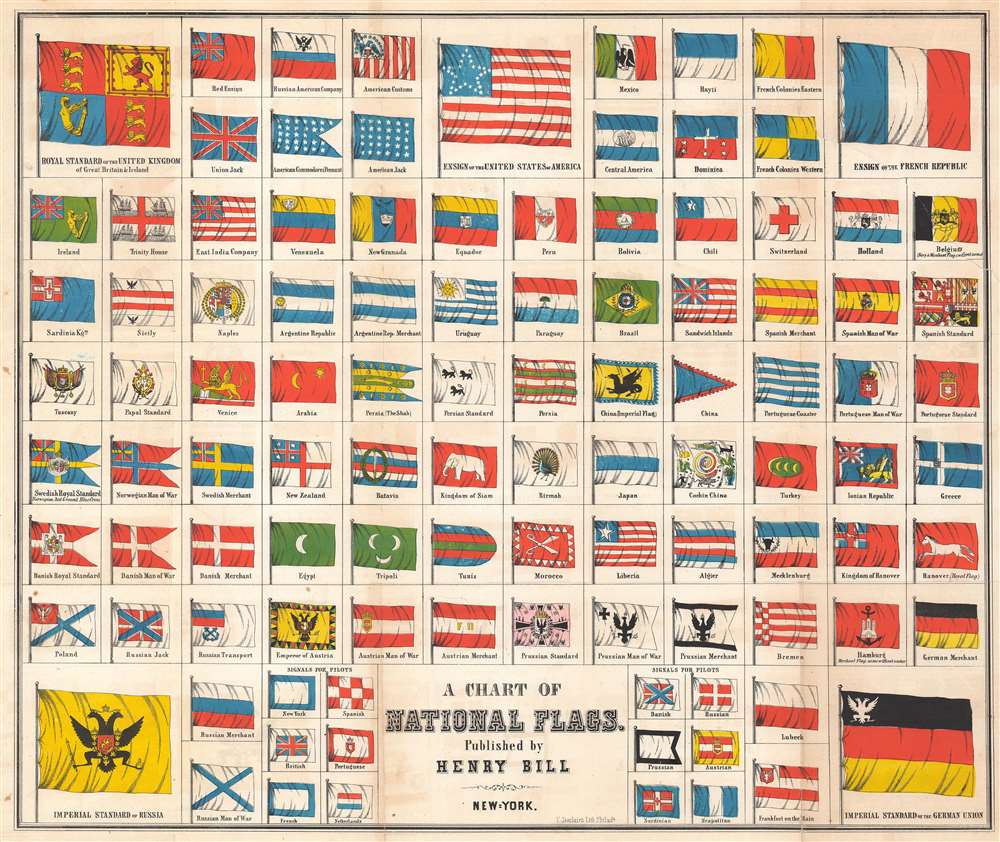This item has been sold, but you can get on the Waitlist to be notified if another example becomes available, or purchase a digital scan.
1851 Bill Chart of National Flags
NationalFlags-bill-1851
Title
1851 (undated) 18.25 x 21.75 in (46.355 x 55.245 cm)
Description
The standards, merchant flags, and flags for 'Man of War' ships of several nations are present as well, including Spain, Russia, Denmark, Portugal, and Prussia. Other flags, such as ones representing the Sandwich Islands and the Emperor of Austria, are no longer used. Some announce British private companies acting under Royal Charter, such as the flag of Trinity House, which is responsible for maintaining lighthouses and other coastal lights for England, Wales, the Channel Islands, and Gibraltar, and the East India Company was an English and later British joint-stock company that operated in East Asia. Several colonial flags, including French West Africa and French East Africa, are also present.
This chart was printed by Thomas S. Sinclair and published by Henry Bill in the 1851 edition of Samuel Maunder's The Treasury of History; Being a History of the World: Comprising a General History, both Ancient and Modern, of All the Principal Nations of the Globe, Their Rise, Progress, Present Condition, Etc..
CartographerS
Henry Bill (May 18, 1824 - August 14, 1891) was an American book publisher. Born in Groton (now Ledyard), Connecticut to Lucy and Burdon Bill, Henry attended the academy in Plainfield as a boy. After graduation, Bill taught in Groton and Plainfield until, at the age of twenty, a relative, James A. Bill, offered him a job in Philadelphia workin for the book publishing business he owned. Bill spend the next three years learning the publishing business and selling books door to door in the western states. Then, in 1847, Bill moved to Norwich where he opened his own publishing firm. The elder of the Harper Brothers of New York recognized his skill and gave Bill support and an unlimited line of credit. Over the following twenty-five years, Bill's publishing company produced hundreds of thousands of books and by 1865 was among the sixty wealthiest men in Norwich. When faced with failing health and the prospect of retirement, Bill converted his business into a joint-stock company, creating the Henry Bill Publishing Company, which continued to flourish for years. Bill was also involved in politics, serving as a member of the State Senate in 1853. As a member of the Democratic Party, when the party split in 1856, he chose the anti-slavery group, and became an active member of the fledgling Republican Party. Bill was also very successful with his real estate investments and was also one of the founders of Chelsea Savings Bank, serving as the bank's vice president from 1858 until 1882. Bill married Julia O. Chapman on February 10, 1847, with whom he had seven children. More by this mapmaker...
Samuel Maunder (1785 - 1849) was an English writer and composer, most well known for The Biographical Treasury and The Treasury of History. Learn More...
Thomas S. Sinclair (c. 1805 - 1881) was an American lithographer. Born in the Orkney Islands, Scotland, Sinclair studied lithography in Edinburgh and other European cities before moving to the United States sometime before 1833. He was established in Philadelphia by 1833, when he drew a dancing scene for the firm of Kennedy and Lucas, which went out of business that same year. In 1838, Sinclair acquired the press of John Collins and opened his own lithography firm. He was among the first lithographers in Philadelphia to experiment with color lithography, beginning in 1843. By 1848, his skills ad advanced to such a degree that he won a silver medal for color lithography at the Franklin Institute's exhibition. Sinclair's brother, William B. Sinclair, joined the firm in 1854, and from that year until 1859 the establishment was known as Thomas Sinclair and Company. His son joined the company at one point also, and then the firm's name changed to Thomas Sinclair and Son. Sinclair died in Philadelphia in 1881. Learn More...

